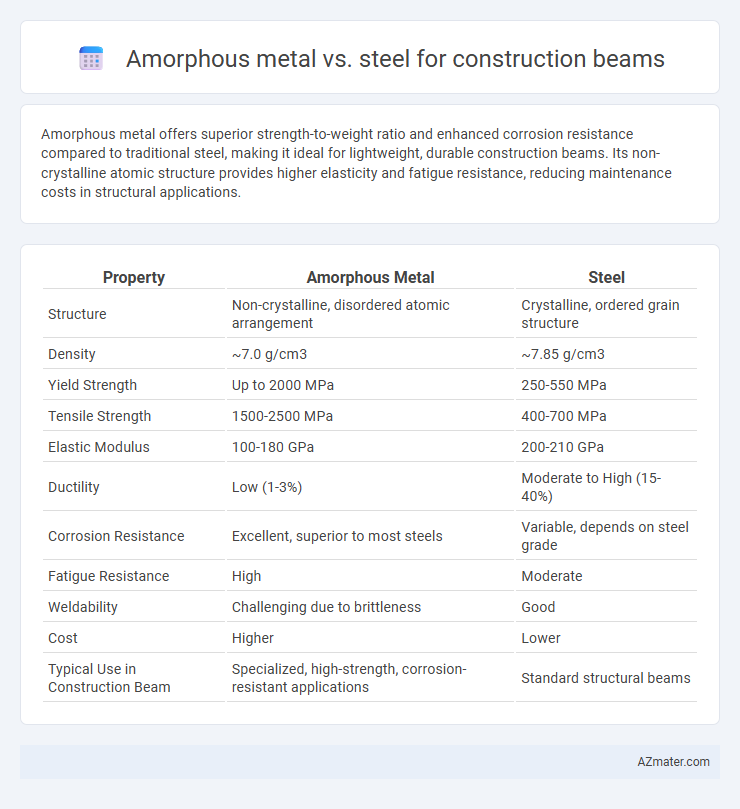Amorphous metal offers superior strength-to-weight ratio and enhanced corrosion resistance compared to traditional steel, making it ideal for lightweight, durable construction beams. Its non-crystalline atomic structure provides higher elasticity and fatigue resistance, reducing maintenance costs in structural applications.
Table of Comparison
| Property | Amorphous Metal | Steel |
|---|---|---|
| Structure | Non-crystalline, disordered atomic arrangement | Crystalline, ordered grain structure |
| Density | ~7.0 g/cm3 | ~7.85 g/cm3 |
| Yield Strength | Up to 2000 MPa | 250-550 MPa |
| Tensile Strength | 1500-2500 MPa | 400-700 MPa |
| Elastic Modulus | 100-180 GPa | 200-210 GPa |
| Ductility | Low (1-3%) | Moderate to High (15-40%) |
| Corrosion Resistance | Excellent, superior to most steels | Variable, depends on steel grade |
| Fatigue Resistance | High | Moderate |
| Weldability | Challenging due to brittleness | Good |
| Cost | Higher | Lower |
| Typical Use in Construction Beam | Specialized, high-strength, corrosion-resistant applications | Standard structural beams |
Introduction to Amorphous Metals and Conventional Steel
Amorphous metals, also known as metallic glasses, possess a disordered atomic structure that offers higher strength and corrosion resistance compared to conventional steel, which has a crystalline structure. Steel beams, widely used in construction, provide reliable ductility and proven performance under various loads but are susceptible to rust and fatigue over time. The unique properties of amorphous metals, such as superior hardness and elasticity, present innovative opportunities for durable and lightweight construction beams.
Structural Properties: Strength and Durability
Amorphous metals, also known as metallic glasses, exhibit superior strength and hardness compared to traditional steel, with tensile strengths often exceeding 2 GPa and exceptional elastic limits. Their atomic structure lacks grain boundaries, resulting in enhanced durability and resistance to wear, corrosion, and fatigue, outperforming conventional crystalline steel. Steel remains widely favored for construction beams due to its ductility and cost-effectiveness, but amorphous metals offer promising high-strength, durable alternatives for specialized applications requiring extreme performance.
Weight and Density Comparison
Amorphous metals exhibit a significantly lower density, typically around 7.0 g/cm3, compared to conventional steel's density of approximately 7.85 g/cm3, resulting in lighter construction beams. This reduction in weight enhances structural efficiency by decreasing load without compromising strength, as amorphous metals maintain comparable mechanical properties to steel. Consequently, using amorphous metals in construction beams can lead to more efficient material usage and easier handling during installation.
Corrosion Resistance and Environmental Performance
Amorphous metals exhibit superior corrosion resistance compared to conventional steel due to their non-crystalline atomic structure, which eliminates grain boundaries prone to corrosion initiation. This property significantly reduces maintenance costs and extends the lifespan of construction beams exposed to harsh environmental conditions. Environmentally, amorphous metals offer enhanced sustainability by requiring less frequent replacement and enabling efficient recycling processes, thereby minimizing resource consumption and reducing the overall carbon footprint of building projects.
Manufacturing Processes and Scalability
Amorphous metals, produced through rapid solidification techniques such as melt spinning or planar flow casting, offer unique manufacturing challenges due to their requirement for precise cooling rates to maintain non-crystalline structures, limiting scalable production compared to traditional steel beams forged through established processes like casting, rolling, and welding. Steel manufacturing benefits from large-scale, mature industrial infrastructure allowing mass production with consistent quality, cost-effectiveness, and adaptability to various beam sizes and shapes. Scaling amorphous metal beams remains constrained by high production costs and limited equipment availability, whereas steel's widespread use ensures robust supply chains and scalability for extensive construction demands.
Cost Analysis and Economic Feasibility
Amorphous metal beams exhibit higher initial material and manufacturing costs compared to traditional steel beams, driven by complex processing and limited large-scale production. Steel remains economically feasible due to its widespread availability, established supply chains, and lower fabrication expenses despite its heavier weight and susceptibility to corrosion. Long-term cost benefits of amorphous metals include reduced maintenance and longer lifespan, but current market conditions favor steel for most construction projects based on upfront cost efficiency.
Design Flexibility and Architectural Applications
Amorphous metal exhibits higher design flexibility compared to traditional steel beams due to its unique atomic structure, allowing for more intricate and lightweight architectural forms without compromising strength or durability. Its superior elasticity and fatigue resistance enable innovative load-bearing designs and complex geometries that are difficult to achieve with conventional steel. These properties make amorphous metal an ideal material for avant-garde architectural applications requiring both aesthetic appeal and structural efficiency.
Lifecycle and Maintenance Considerations
Amorphous metal beams offer superior corrosion resistance and reduced wear, significantly extending lifecycle compared to traditional steel beams, which are prone to rust and fatigue. Maintenance requirements for amorphous metal are lower due to their enhanced durability and resistance to environmental degradation, resulting in cost savings over time. Steel beams demand regular inspections, coatings, and repairs to prevent structural weakening, increasing operational expenses throughout their service life.
Safety Standards and Building Codes Compliance
Amorphous metals exhibit superior strength-to-weight ratios and enhanced corrosion resistance compared to traditional steel, making them a promising material for construction beams under stringent safety standards. Compliance with international building codes such as the International Building Code (IBC) and Eurocode necessitates thorough testing of amorphous metal beams to ensure they meet load-bearing, fire resistance, and seismic performance requirements. Current challenges include standardization and certification processes, but ongoing research aims to validate amorphous metals as code-compliant structural elements in modern construction.
Future Trends in Construction Beam Materials
Amorphous metals, known for their non-crystalline atomic structure and superior strength-to-weight ratio, are emerging as transformative materials in construction beam applications, potentially surpassing traditional steel in durability and corrosion resistance. Advances in nanotechnology and material science are driving the development of cost-effective manufacturing processes for amorphous metal beams, making them viable candidates for sustainable and high-performance infrastructure. Future trends indicate an increased integration of amorphous metals in smart construction systems, enhancing structural resilience and extending the lifespan of buildings compared to conventional steel beams.

Infographic: Amorphous metal vs Steel for Construction beam
 azmater.com
azmater.com